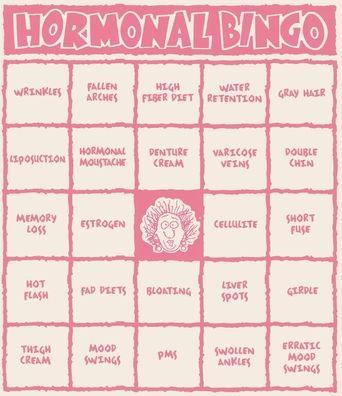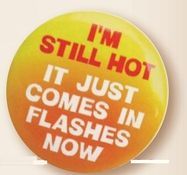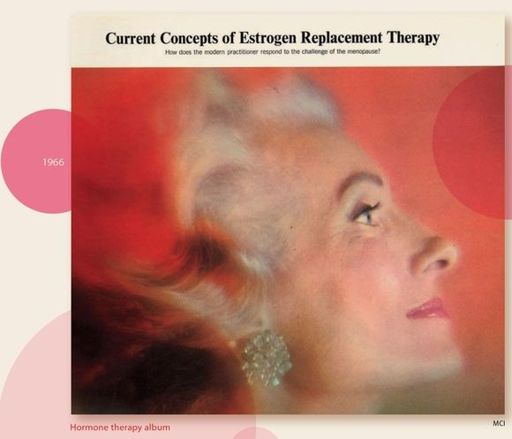Flow: The Cultural Story of Menstruation (31 page)
Read Flow: The Cultural Story of Menstruation Online
Authors: Elissa Stein,Susan Kim
Tags: #Health; Fitness & Dieting, #Women's Health, #General, #History, #Historical Study & Educational Resources, #Politics & Social Sciences, #Women's Studies, #Personal Health, #Social History, #Women in History, #Professional & Technical, #Medical eBooks, #Basic Science, #Physiology

For the record, I will miss my period. I usually get it on the seventh of every month, and have so since I was ten. I like feeling in the cycle of my body.
—Harriet F. (47)
For those of us lucky enough to get old, menopause is a lot like menarche: it’s definitely something we will all experience, sooner or later. And like a ten-year-old girl reading Are You There God? It’s Me, Margaret for the first time, we may well feel frightened about the whole thing, or curious, or resigned, or oddly at peace with it. Mostly, we probably all have questions: When will it start? What will it feel like? How long will it last? And how will I feel when I’m not menstruating anymore?

And yet, wouldn’t it be wonderful never having to worry about birth control ever again? Or about getting pregnant? No more bleeding … couldn’t that be liberating? And what about not having to buy another pad or tampon? To not have to worry about leaks, cramps, and hot flashes? To never need to run to the drugstore in a panic for either a box of tampons or a pregnancy test?
At least menopause, as a subject, is no longer hidden in some drawer along with the old underwear. Perimenopausal, menopausal, and postmenopausal women wanting information constitute a huge market, and businesses are looking to cash in. Just go online to a good search engine and type in “menopause”—you’ll practically crash your computer from all the hits. It’s possible to buy wisdom journals and T-shirts that say things like HELP … WHO TURNED UP THE HEAT?! and RED HOT MAMA, find special diet, exercise, and yoga programs, learn how to reinvent one’s sex life. There’s even a Chicken Soup book for the menopausal soul. One can determine one’s “menopause type,” learn tricks to combat cognitive losses, research Chinese medicine therapies—even get tips on surviving male menopause, as if one’s own weren’t enough. One can amuse oneself with Menopop (a pop-up and activity book), or buy menopause-specific sleepwear, pillowcases designed to quickly wick sweat away, or a subliminal programming CD designed to alleviate menopausal symptoms. One can browse skin-care products developed especially for menopausal (we’re not sure if that’s much better than “aging”) skin and find lubricants to help make sex fun again. One can even order tickets to see Menopause—The Musical, which has been playing around the country since 2001. Or if not, one can buy the CD and songbook.
I love passing the feminine hygiene product aisle and knowing that’s one less thing I need to buy. I feel as though I’ve paid my dues and I made it through. I wouldn’t go back if you paid me. I love not getting my period.
—Stacey S. (53)

While some of the above may sound silly or even exploitative, we’re heartened by the fact that at least women are talking about menopause and perhaps learning to accept it as an inevitable part of life. Hey, we’re not suggesting it’s supposed to be a day at Six Flags for everyone … but at least thanks to the ongoing dialogue, information, and even humor, menopause is no longer seen as the catastrophic end of a woman’s life. Instead, it’s becoming what it should have been all along: just another change.
I think I will be as excited as I was the first time I got my period—very happy and very proud to have reached this milestone. this milestone.
—Julia B. (47)
OUTSIDE THE BOX
I
N 1980, COMMERCIAL FEMCARE WAS SWEPT UP in a nationwide scandal. Thirty-eight girls and women had died of Toxic Shock Syndrome (TSS), a rare blood infection brought on by new-and-improved , superabsorbency tampons like Procter & Gamble’s Rely (whose ad line, creepily enough, was“It even absorbs the worry”).
Since then, all tampon manufacturers have phased out the most harmful ingredients. They also implemented a standardized absorbency rate and started plastering their packaging with dire warnings about TSS symptoms (sudden fever, vomiting, diarrhea, aches). Yet despite these precautions, there are still cases of TSS floating around. The official Web site of Stayfree, not what you’d call a hotbed of menstrual activism, says that one to seventeen of every 100,000 menstruating females will contract TSS every year (although these days, few cases are fatal).
As if that weren’t enough to lose Jane Menstruator sleep, there’s also the possible presence of dioxin in tampons. Dioxin isn’t a single thing, but a family of chemical compounds, a very mean and evil family that are highly carcinogenic and toxic. Dioxins build up in animal tissue, where they just stay on and on and on, like extremely undesirable house guests.
Repeated tests have revealed only trace amounts of dioxin in tampons, well below the threshold that causes cancer. And yet talking about “a really small amount of dioxins” may be akin to calling someone “a little pregnant” or “kind of dead.” After all, the stuff does build up. What’s more, even though such low levels may not cause cancer, they might be linked to other problems, like endometriosis. None of this has been proven definitively, but it still gives one serious pause.
With the depressing realization that conventional, commercially available products can actually carry a drawback or two, including environmental ones (femcare products and packaging are a major contributor to landfills worldwide), women are understandably more open to exploring other options when it comes to dealing with menstrual flow, cramps, PMS, perimenopause, and postmenopause. And while we would never discount commercial products outright since far too many women (including us) rely on them, isn’t it nice to have intriguing and often effective choices?
MYTH DEBUNKER
Worried about asbestos in your tampon? According to this widely spread online rumor, the major tampon companies have been sneaking the deadly material into their products just to make us bleed more. Dating back to the late 1970s, the asbestos-in-tampons rumor is emphatically just that, an urban myth along the lines of the camper who gets bitten by an insect and later has newly hatched baby spiders pouring out of his cheek. While tampons do contain other potentially troublesome ingredients like bleach, surfectants, waxes, alcohols, acids, and hydrocarbons, rest assured asbestos isn’t one of them.
WACKIEST FEMCARE PRODUCTS
• A hormone replacement therapy album
• Rubber sanitary aprons
• A menopause pop-up book
• Baby wipes repackaged for women
• Hot flash pillowcases

Take, for instance, the menstrual cup. First introduced, albeit not very successfully, in the 1930s, the menstrual cup is now beloved by many women who can’t imagine a world without it. One can opt for the disposable kind, which is used once and then thrown away. Far more popular, however, is the reusable cup, which, if cared for properly, can last for up to ten years. There are numerous brands currently available online and in drugstores, including the Diva Cup, the Keeper, the Moon Cup, and Lunette.
Think about it … at roughly thirty bucks a pop, menstrual cups can be quite the bargain! And considering that the average woman will throw away 250 to 300 pounds of pads, plugs, and applicators in her lifetime, one would also save oneself significant guilt about dumping all that waste into our already-stressed environment. A menstrual cup can hold far more than any tampon, up to a full fluid ounce, making it a great option for heavy bleeders. It can be safely left in place for twelve hours, has never once been linked to TSS, is incapable of irritating or drying out the vagina, and what’s more, it never leaks!
The menstrual cup is now beloved by many women who can’t imagine a world without it.

“So how does it work?” you may be grudgingly wondering. And just as important, what’s the catch?
Made of silicone or rubber, a menstrual cup looks vaguely like a small, flexible Liberty Bell, minus the clapper and the crack. One folds the cup in half and inserts it (if one has ever used a diaphragm, one will immediately know what this entails); once inside, it pops open, creating an effective vacuum seal that keeps any blood from leaking out. To get it out, one must break the seal with one’s finger and carefully yank it out, which can be a tad tricky and may on one’s first attempt send bloody goo flying in all directions. Then one dumps out the contents, rinses it thoroughly, and reinserts.
Ta-da!
The catch isn’t a catch to those who use it regularly and swear by its ease and comfort; and yet there are many of you out there (you know who you are) who are already shaking your heads in an emphatic “no.” All that touching, all that inserting! Besides, who wants to handle her own blood that intimately? What’s more, for heavy bleeders in the workplace, the thought of possibly having to wash one’s menstrual cup out in a communal sink is about as appealing as seeing someone floss her teeth on the subway. Perhaps this is why the menstrual cup has never gone mainstream in America and continues to wait patiently in the wings for its big launch.
Another product that didn’t quite make it was the Padette. A so-called interlabial pad, it was launched in 1995, and from the early reviews, one would have thought the company had found a cure for cancer. The Padette was a strange mutant, part pad, part tampon, and not quite either. Specifically, it was a small, oval pad, a mere three inches in length, that was designed to be held in place comfortably by one’s labia. When a woman was standing or sitting, the labia would hold the pad in place; when she was on the toilet, the pad would fall out on its own, where it could be flushed away. Best used for short spells on light days, the Padette was beloved by the few who tried it, but then quickly disappeared. As of early 2008, it’s currently being reintroduced as the Unique miniform.
